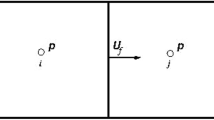Abstract
This paper presents a technique for determining the types of discontinuities in the numerical solution of various problems of gas dynamics. The relevance of the topic is determined by the fact that in complex gas-dynamic formulations, the correct definition of the regions occupied by rarefaction waves (RWs), contact discontinuities, and shock waves (SWs) is required. The choice of the scheme for the numerical solution of the problem depends on the correct definition of such regions. In this paper, we present a technique that makes it possible to determine in a unified way the boundaries of regions containing discontinuities and waves of various types. To do this, in terms of the required gas-dynamic functions, inequalities are derived that single out such regions. This information is used when modifying known or constructing new difference schemes in order to increase their stability and/or monotonicity. For example, the resulting inequalities allow us to single out numerical schemes whose solutions satisfy the requirement of a nondecreasing entropy. The main consideration is given in the one-dimensional case. The technique is generalized to the multidimensional case. Examples are given of applying the technique to solving a number of well-known test problems in gas dynamics.







Similar content being viewed by others
RЕFERENCES
P. L. Roe, “Approximate Riemann solvers, parameter vectors and difference schemes,” J. Comput. Phys. 43 (2), 357–372 (1981). https://doi.org/10.1016/0021-9991(81)90128-5
G. A. Sod, “A survey of several finite difference methods for systems of nonlinear hyperbolic conservation laws,” J. Comput. Phys. 27 (1), 1–31 (1978). https://doi.org/10.1016/0021-9991(78)90023-2
B. van Leer, “Flux-vector splitting for the Euler equations,” in Proc. Eighth International Conference on Numerical Methods in Fluid Dynamics, Ed. by E. Krause, Lecture Notes in Physics, Vol. 170 (Springer, Berlin, 1982), pp. 507–512. https://doi.org/10.1007/3-540-11948-5_66
E. F. Toro, “TVD regions for the weighted average flux (WAF) method as applied to a model hyperbolic conservation law,” Report No. 8907 (College of Aeronautics, Cranfield Institute of Technology, 1989).
G.-S. Jiang and C.-W. Shu, “Efficient implementation of weighted ENO schemes,” J. Comput. Phys. 126 (1), 202–228 (1996). https://doi.org/10.1006/jcph.1996.0130
A. Harten and S. Osher, “Uniformly high-order accurate nonoscilatory schemes,” SIAM J. Numer. Anal. 24 (2), 279–309 (1987). https://doi.org/10.1137/0724022
N. A. Dar’in, V. I. Mazhukin, and A. A. Samarskii, “A finite-difference method for solving the equations of gas dynamics using adaptive nets which are dynamically associated with the solution,” USSR Comput. Math. Math. Phys. 28 (4), 164–174 (1988). https://doi.org/10.1016/0041-5553(88)90127-9
V. I. Pokhilko and V. F. Tishkin, “Uniform algorithm for computation of discontinuous solution on adaptive grids,” Mat. Model. 6 (11), 25–40 (1994).
N. V. Mikhailova, V. F. Tishkin, N. N. Tyurina, A. P. Favorskii, and M. Yu. Shashkov, “Numerical modelling of two-dimensional gas-dynamic flows on a variable-structure mesh,” USSR Comput. Math. Math. Phys. 26 (5), 74–84 (1986). https://doi.org/10.1016/0041-5553(86)90043-1
B. L. Rozhdestvenskii and N. N. Yanenko, Systems of Quasilinear Equations and Their Applications to Gas Dynamics (Nauka, Moscow, 1968; Am. Math. Soc., Providence, RI, 1983).
L. V. Ovsyannikov, Lectures on the Fundamentals of Gas Dynamics (Inst. Komp. Issled., Moscow–Izhevsk, 2003) [in Russian].
L. D. Landau and E. M. Lifshitz, Fluid Mechanics, 2nd ed., Course of Theoretical Physics, Vol. 6 (Nauka, Moscow, 1986; Pergamon, New York, 1987). https://doi.org/10.1016/C2013-0-03799-1
B. Riemann, “Über die Fortpflanzung ebener Luftwellen von endlicher Schwingungsweite,” Abh. Königl. Ges. Wiss. Göttingen 8, 43–66 (1860);
Russian tranls.: “On the propagation of plane waves of finite amplitude,” in Works (Gostekhizdat, Moscow, 1948), pp. 376–395.
N. E. Kochin, “On the theory of liquid discontinuities,” in Collected Works, Vol. 2 (Izd. Akad. Nauk SSSR, Moscow, Leningrad, 1949), pp. 5–42 [in Russian].
L. D. Landau and E. M. Lifshitz, Continuum Mechanics (Gostekhizdat, Moscow, 1954) [in Russian].
S. K. Godunov, A. V. Zabrodin, M. Ya. Ivanov, A. N. Kraiko, and G. P. Prokopov, Numerical Solution of Multidimensional Problems of Gas Dynamics (Nauka, Moscow, 1976) [in Russian].
I. V. Popov and I. V. Fryazinov, “Adaptive artificial viscosity for multidimensional gas dynamics for Euler variables in Cartesian coordinates,” Math. Models Comput. Simul. 2 (4), 429–442 (2010). https://doi.org/10.1134/S2070048210040034
I. V. Popov and I. V. Fryazinov, “Method of adaptive artificial viscosity for gas dynamics equations on triangular and tetrahedral grids,” Math. Models Comput. Simul. 5 (1), 50–62 (2013). https://doi.org/10.1134/S2070048213010080
R. Liska and B. Wendroff, “Comparison of several difference schemes on 1D and 2D test problems for the Euler equations,” Preprint 2001-049, Conservation Laws Preprint Server (November 22, 2001). https://www.math.ntnu.no/conservation/2001/049.html
I. V. Popov and I. V. Fryazinov, Method of Adaptive Artificial Viscosity for the Numerical Solution of Gas Dynamics Equations (KRASAND, Moscow, 2014) [in Russian].
ACKNOWLEDGMENTS
The author thanks his colleagues Yu.N. Karamzin, S.V. Polyakov, E.B. Savenkov, and Yu.A. Kriksin for their helpful discussions of the results of this study.
Funding
This study was supported by the Russian Foundation for Basic Research and the National Science Foundation of Bulgaria (no. 20-51-18004).
Author information
Authors and Affiliations
Corresponding author
Ethics declarations
The author declares that he has no conflicts of interest.
Rights and permissions
About this article
Cite this article
Popov, I.V. Technique for Determining the Types of Discontinuities in the Calculations of Gas Flows. Math Models Comput Simul 15, 725–734 (2023). https://doi.org/10.1134/S2070048223040130
Received:
Revised:
Accepted:
Published:
Issue Date:
DOI: https://doi.org/10.1134/S2070048223040130




